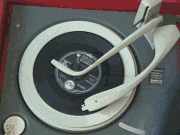The records pressing.
The soft master known as a "Lacquer" would then be electroplated with a metal, commonly a nickel alloy (this and all subsequent metal copies were known as "matrices" or singular "matrix"). When this metal was removed from the Lacquer, it was a copy of the Lacquer and of the yet to be produced record. In the UK, the copy from the lacquer was called the "Master". In the earliest days the Master was used as a mold to press records sold to the public, but as demand for mass production of records grew, another step was added to the process. The metal Master was then electroplated to create "Mothers".
From the "Mothers", "Stampers" would be formed. The Stampers would be used in hydraulic presses to mould the LP discs. The advantages of this system over the earlier more direct system included ability to make a large number of records quickly by using multiple stampers. Also, more records could be produced from each Master since molds would eventually wear out.Since the Master was the unique source made to ultimately produce the Stampers, it was considered a Library Item. The "Pedigree" of any record can be traced through the Mother/Stamper identities used, by reading the lettering found on the record run-out area.
Lacquers make Masters which in turn produce Mothers which then create Stampers. So for your Parlophone records, the Master is the matrix at the 6 o’clock position, the Mother is the number etched in the deadwax at the 9 o’clock location and the Stamper is identified by the letter(s) etched at the 3 o’clock postion. For the 3 o’clock position, Parlophone use the following coding: G R A M O P H L T D (Gramophone Ltd) where G=1, R=2, A=3, M=4, O=5, P=6, H=7, L=8, T=9 and D=0. Therefore, many times you will see more then one letter etched in the dead wax in the Stamper location (3 o’clock). For example, if "MM" is etched, it means the record was pressed with the 44th stamper. The ultimate early pressing of any Beatles Parlophone LP would be denoted with the codes 1/G 1/G (side 1 and side 2), where the "1″ represents the first Mother (9 o’clock) and the "G" denotes the first Stamper (3 o’clock) or one of the first 300 off the press!
Decoding.
The picture below illustrates where to locate the information to date your Parlophone record:
1.Lacquer (Matrix or Master) (6 o’clock)
2.Mother produced from the Master (9 o’clock)
3.Stamper produced from the Mother (3 o’clock)
The tax codes are located next to the record spindle hole. Here are the dates to help you date your Parlophone record:
ZT-April 1962 through November 1962
PT-November 1962 through January 1963
MT-January 1963 through July 1963
KT-July 1963 through January 1969































